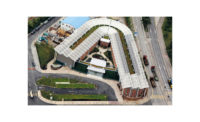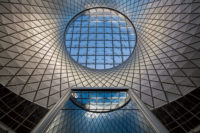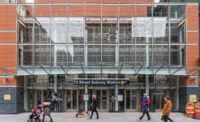Set in a newly developed part of Hong Kong, the Sunny Bay MTR Station combines sophisticated engineering with nature itself to show how even infrastructure projects can stand as examples of sustainable design. Aedas Limited and Arup worked together on the project, which serves as an interchange station between the Tung Chung Line and the Disneyland Resort Line, to create a spiraling tentlike structure that uses only one-third of the energy typically need to power a station of this size.
By designing a stucture that is open at either end and captures the breezes moving across the site, Aedas and Arup used nature to help cool the building. The informal quality of the project seems particularly appropriate since the building serves as the starting off point for people traveling to Hong Kong Disneyland. “It would have been easy to build an air-conditioned box, but we looked at the site and harnessed what it could offer,” says Max Connop, an Aedas director who oversaw the project.
At the start of the design process, Connop realized that the site on Lantau Island—nestled between the sea and hills—offered the opportunity to harness the cooling power of wind. To its credit, the MTR Corporation, a publicly-traded company that runs Hong Kong’s local and commuter rail network, accepted the idea of making Sunny Bay the system’s first station that isn’t totally enclosed.
The station has a lightweight steel frame with bow-string trusses that is wrapped with a curving fabric made of Polytetraflouroethylene (PTFE). Aedas and Arup oriented the fabric structure in the direction the winds and calculated its curvature to optimize air movement within the envelope. During the design phase, the structure was modeled to make sure that hot air rises along the curved ceiling while cool breezes sink to the platform level to generate a comfortable microclimate. Hot air escapes near the top of the structure, through gently sloped glass louvers that also shield the station from torrential monsoon rains. The station’s open sides at both ends of the rail platforms also contribute to the natural ventilation. A chloroflurocarbon-free water mist cooling system acts as a backup measure and can bring the temperature down by 4 to 6 degrees Celsius, enough to make the covered space pleasant even in the humid summer months.
The designers used Teflon-coated PTEF fabric for the roof, in part because it cleans itself. To make the roof easier to assemble and maintain, they broke the roof structure into separate bays punctuated by narrow glass screens. Because it is translucent, the fabric allows softened daylight to shine indoors, significantly reducing the need for electric light during daytime.
By designing a lightweight structure for the roof, Aedas and Arup could use a raft foundation that requires much less site excavation than is typical on a project of this size. They also reduced the building’s impact on its surroundings by using pre-cast elements shipped to the site during construction.








